In recent years, the Western Balkans have found themselves caught at the center of a geoeconomic rivalry. The EU, China, Russia, and the United States all use their financial power to advance in the region by giving loans, grants, and buying strategic assets.
What do these financial flows reveal about the economic game of influence being played there? To answer that, we’ve invited Branimir Jovanović, an economist and expert on the Western Balkans. In this talk, he’ll share what stands behind the significant finance coming into the region and how major powers can use it to pull the strings.
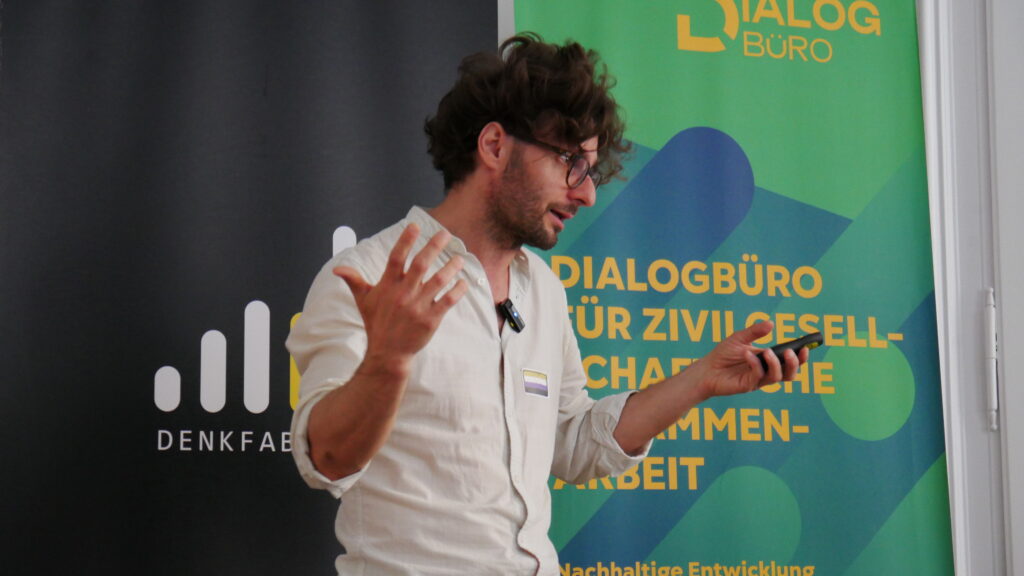
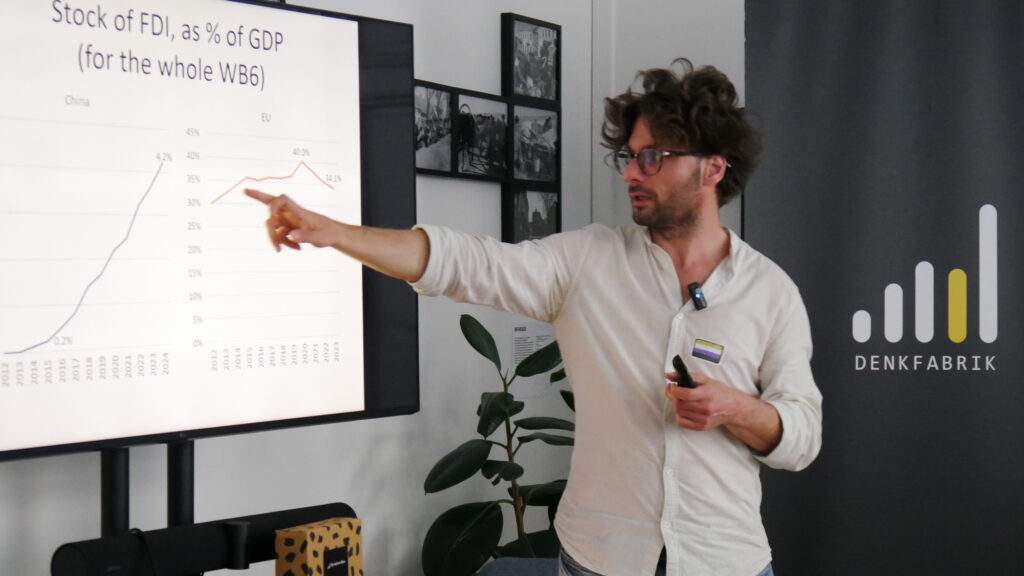

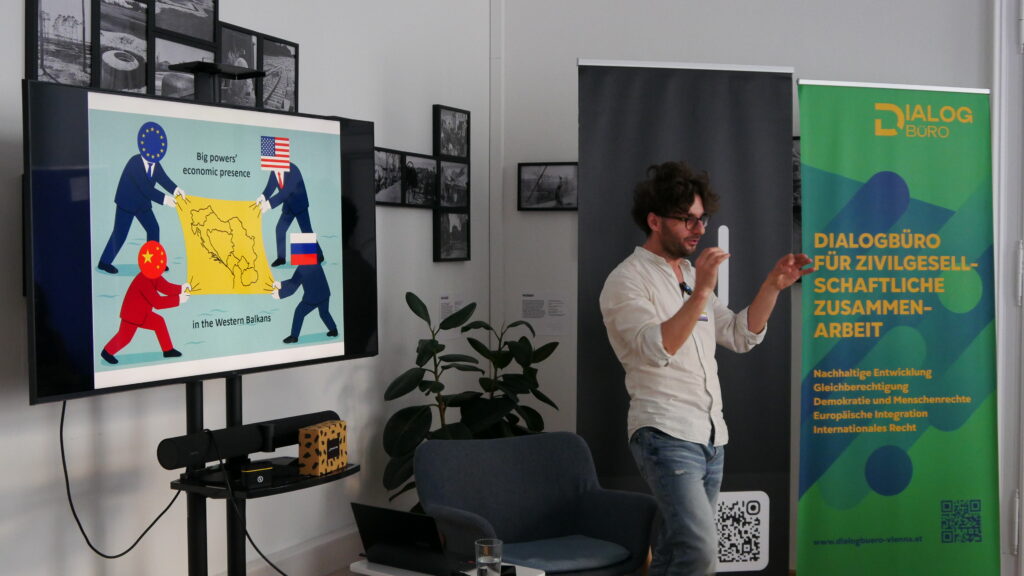
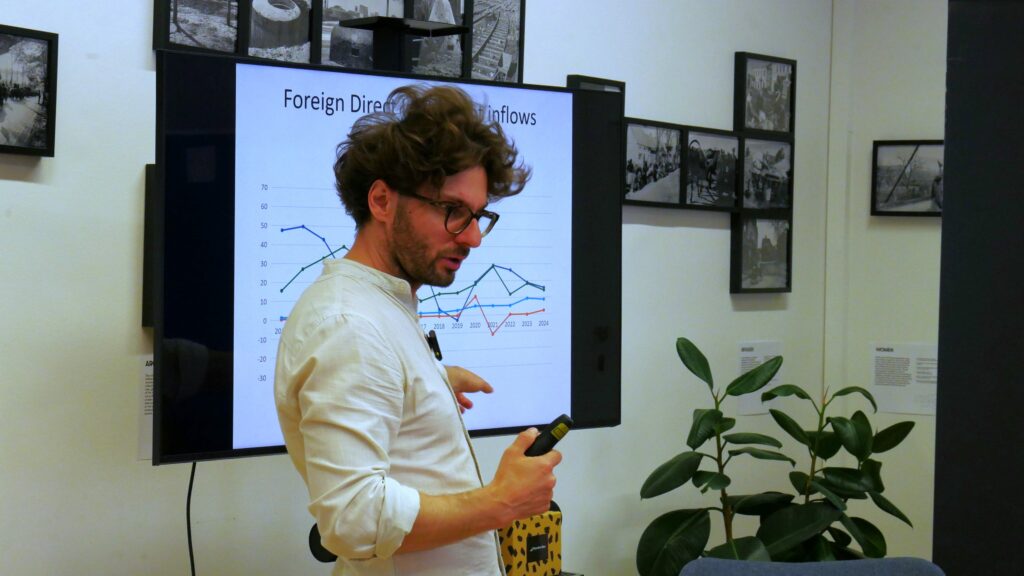
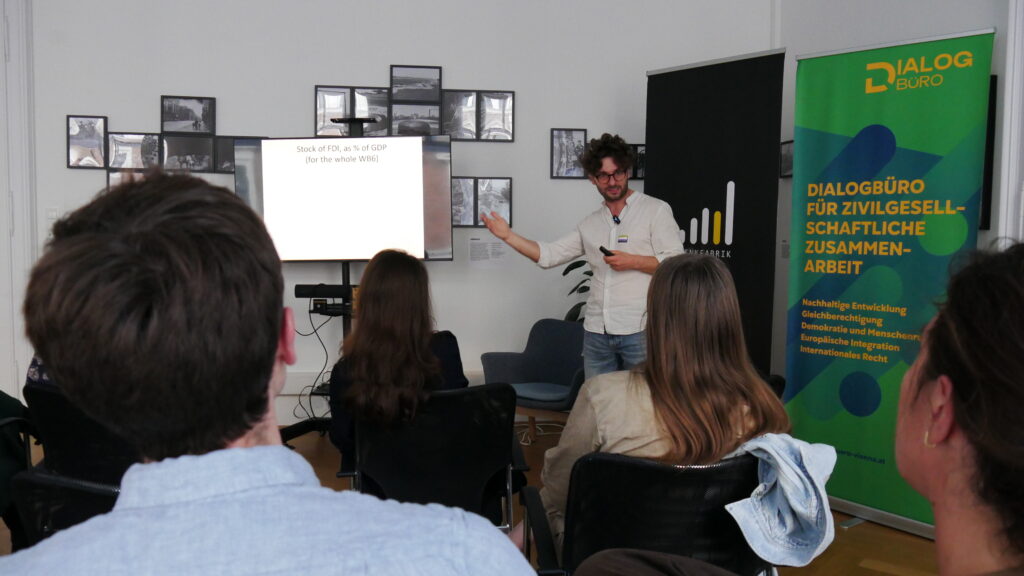
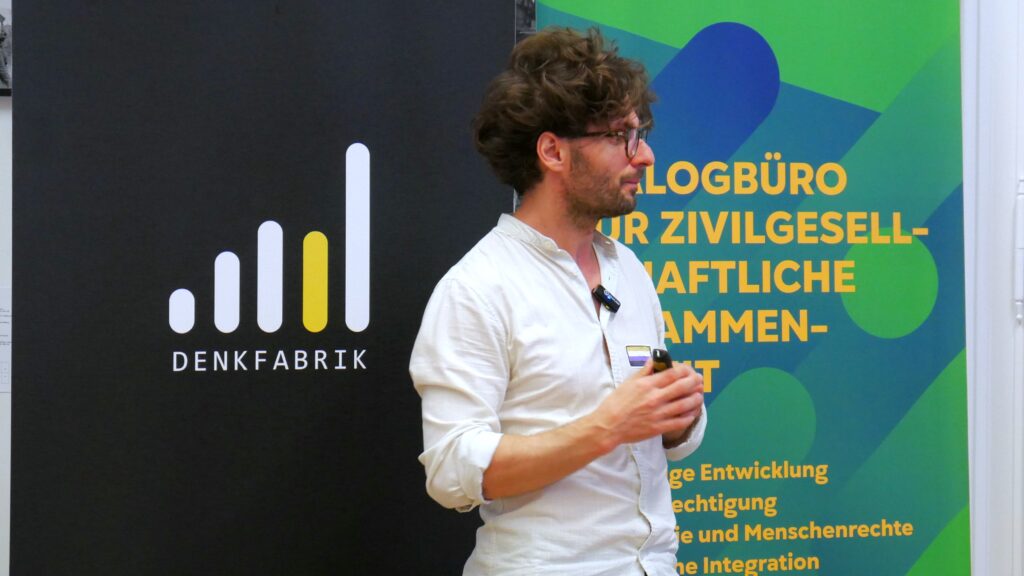

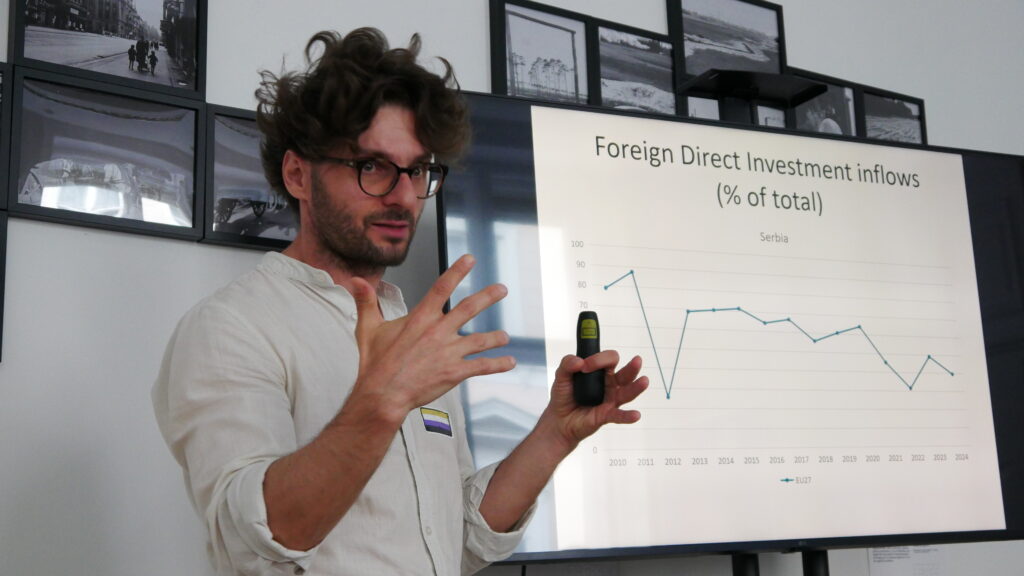
Read Full Transcript
So, the plan of the talk is:
First, I’ll give you a snapshot of the economic presence of the big four: America, EU, China, and Russia in the Balkans. A very, very rough screenshot of their presence.
Then, I’ll zoom in a bit more on the presence of the EU and China as the biggest actors in the region, because Russia and America are not as significant, at least in an economic sense.
Next, I’ll discuss something that might be more interesting to you: the motives behind their presence. Not just behind their presence, but also the motives behind the whole story. So, why are the Balkans kind of accepting the influence or economic presence of these powers, and why do these powers try to be in the Balkans? A political economy point of view.
And then, for the last point, “What is to be done?” which is totally subjective, my opinion. The first two things are purely database, macroeconomic analysis, descriptive, of course. Then we are going towards a more narrative analysis.
Foreign Direct Investment (FDI) in the Western Balkans
First, the first thing I want to show is, do you know what FDI is? How many of you know what FDI is? Okay, you know, good. So, FDI is Foreign Direct Investment, meaning this is the investment that foreign companies make in another country. For example, if we’re in Austria now, it’s the investment that German companies make in Austria, or American companies, or Russian companies, or Chinese companies make in Austria. That’s FDI. So, if an American company opens a factory in Austria, that’s FDI. If a Chinese company opens a supermarket in Vienna, that’s FDI. Things like that.
FDI is one of the most common, most standard ways of being present in a country in an economic way. Because, you know, companies from the West invest in the Balkans, so that’s like the presence of the West in the Balkans.
This first figure shows you the FDI, the foreign investment of companies, of private entities, coming from the EU in Serbia over the last 15 years, from 2010 until 2024. And this is as a percentage of the total foreign investment in the country. What can we see here? For example, at the beginning of the 2010s, about 15 years ago, around 80 to 90 percent of all investment coming into Serbia was from the EU. So, most companies that opened factories or supermarkets or whatever in Serbia, 80-90% of them were from the EU.
Then you see a big decline here. That’s because of the financial crisis. Then you see some recovery. But after that, you see the level is around 70% here, gradually declining. The trend is certainly downwards, from 80% in the beginning to around 40% lately, in the last several years. This is the investment made in this year, not the total factories you have in your country, but just the new investment that happens in that year.
Now, this is the investment of U.S. companies in the Balkans. You see, virtually zero, 2-3%. Fairly constant, no increase, nothing. I mean, some jump here, but otherwise very low. So, the U.S. is not present in Serbia in terms of FDI.
This is Russian FDI. Again, some fluctuations, some periods above 10%, but on average around 5% or something. And in the last several years, around 2-3%. So, Russia is virtually non-existent.
And this is China. China was zero 10 years ago. See the trend, upward, upward, upward, growing, growing. In the last several years, China is around 30%. And I think in 2024, we have 24 here, so in the last several years, Chinese investment became number one in terms of individual countries in Serbia, and almost on par with the total EU. The EU is not one country, but 27 countries. So, China really, really, really increased its share in investment in Serbia. You see, basically, the decline that we see in the EU is an increase in China. It’s a kind of mirror image. The EU is declining, China is increasing. So this is basically the main story, the main thing that I will be talking about.
This is about Serbia, and these are flows. New investment coming into Serbia over the last 15 years. China going up, EU going down, Russia and America low.
This is the same story about Bosnia and Herzegovina. The story is different. You will see that the EU is, of course, number one again. It’s number one in Serbia too. But we see that the EU is dominating. The EU is constantly number one. It’s not going down to 30-40%. And China is not increasing. You see, on the other hand, Russia has some fluctuations up and down. But definitely in Bosnia, the EU dominates. And we don’t have a big, big Chinese presence there.
Albania, slightly different. The EU is dominating again. But not just dominating, but also growing, around 50-40%. The problem in Albania, shares are much lower than in other countries, is that a big part of the FDI in Albania is not classified by countries. So you have investment where they don’t say where it comes from. It might also be money laundering. People say illicit, whatever things. You open a hotel in tourism, whatever. You don’t know who the owner is. But still, of those data which are available, the EU is dominating. China is very low. America is very low, and you see Russia doesn’t even figure out. They don’t even publish how much investment they have from Russia.
Then we have North Macedonia, my home country. It’s fluctuating up and down in terms of the EU, but the EU is still dominating around 80% of the total inflows, new investment in Macedonia, come from the EU. Others are very low.
Kosovo, a very similar story. You see here, Russia is also absent. China is zero. China doesn’t recognize Kosovo as an independent country, so they don’t even invest. So China is zero. Russia is not shown. So the US is here maybe around 10%, but still the EU is dominating.
And this is Montenegro. Montenegro, the smallest, but maybe not the most interesting, but very interesting country anyway in terms of FDI. Because you see, the EU is, yes, kind of number one, but here Russian investments are very, very big in the last several years. It’s not China, but Russia, who has very strong investment in Montenegro. And this is because, first of all, of the many Russians who came to Montenegro after the war. Because when they open a company, that’s classified, that’s recorded as Russian investment. But also tourism, like big hotels, Russian oligarchs, you know the story. So in Montenegro, the story is much more complicated, much more kind of evenly spread. But again, we can say that the EU is dominating. China is not so big here. But Russia is big here.
But anyway, if you take the region as a whole, the main point will be that the EU is number one in terms of investment. China is number two. And Russia and America are much, much lower, much behind. So because of that, I will be focusing in my further points on Chinese and EU presence in the region.
Other Economic Indicators & Stock of FDI
You can do this for other indicators. I didn’t include other indicators because I don’t want to show you a bunch of similar figures like exports, imports, and other stuff. But if you analyze them, the story is very similar. The EU is number one. China is number two. And the EU is slightly going down. China is slightly going up. The others are kind of fluctuating up and down, but much less. So, because of that, I will focus on the EU and China in my further talk now.
I will show you another set of figures about FDI, for investment. So, this is company investment, private investment. I’m making the distinction again because later on I’ll be speaking about public investment, like investment that countries, governments, or whatever public entities make, or loans that they give to countries like roads and things like that, highways. But so far, this is factories. Let’s put it this way: these are factories.
Now, so this is FDI, meaning private investment. But this is the total amount of investment that you have in the whole region. So this is for the whole region. And this is as a share of GDP. So far, it was as a share of total investment. This is a slightly different figure. Do you know what GDP is? Anyone who doesn’t know what GDP is? Okay, GDP is basically the whole production that you have in one country in one year. So, for example, North Macedonia, my home country, produces in one year in total 15 billion euros of goods and services, like cars, tomatoes, hotels, everything. If you sum it together, it’s 15 billion euros. So, what I express here is how much of these 15 billion euros that I have produced this year, what’s the foreign companies’ share in these 15 billion euros, if I can put it that way.
What do we see here? So this is for the whole region, I’m repeating, for the whole Balkans. This is China. Chinese stock of FDI in the economy. So you see, the latest figure is around 4%. So 4% of the GDP in the Balkans is basically owned by Chinese, if you can put it that way. So it’s small, it’s not big. But look at the pace of increase. It’s exponential. Like five years ago, or seven, eight years ago, it was 0.2. An increase by a factor of 20, from 0.2 to 4.2, 21, in a matter of less than a decade. So that’s a huge, huge increase. If this trend continues, you know, I mean, we’ll see later on where this will go. So the main message here is that Chinese presence, I was showing you data on China, but this for the whole region, another way of putting it, Chinese presence is definitely increasing substantially in the region.
And this is the EU. So you see, the EU is much bigger, around 40%, 30-40%. So the numbers here are smaller than before because this is, like I’m repeating once again, total stock of FDI and as a share of GDP, not just investment. So the number, that’s why this is 40 and this 40 is not directly comparable to the 80 we were talking about before. But you see here that the EU was growing in this period from 30 to 40. And then look, since the pandemic, it’s going down from 40 to 34% in a matter of three, four years. So this is basically the same story that I was explaining before. China going up, EU going down, just shown in another way, but also shown for the whole region so that you see that the story that I’m saying about Serbia is not only Serbia, but this is actually the whole region. Because if you’re talking about China, I’ll speak about this later on in more details. China doesn’t think about, you know, Serbia, Montenegro, Bosnia, whatever. They think about the Balkans as a whole region. So that’s why we also have to think in that way.
So another thing, if you look at Chinese FDI, so factory investment, China, private investment in the region, their total investment stock is around 6 billion euros. So, I mean, is it big or is it small? Up to you to decide. But 5.6, to be more precise, almost all of it, or precisely 96% of it, is in Serbia. The green area is Serbia. All other countries, economies, whatever, less than 5% or around 4% combined. So China invests only in Serbia, not the others.
So this is the EU investment. So remember the figures, like here 6 billion total investment, here it’s much more, 52 billion. EU investment, but you see how much more dispersed it is. Like, slightly more than half of it is Serbia, but you see everyone else has some big share. So, see this picture, all of these 1%, each of them. See this, like Albania, 7%, you see the others. I mean, you can’t read some of them, but it doesn’t matter. You can see this probably in Bosnia, it doesn’t matter. The main message is first that EU investment, FDI, is much bigger than Chinese in terms of these billions. But also that EU investment is spread much more evenly. So EU invests, EU factories, EU companies, they invest also in Albania, in Macedonia, in Bosnia, everywhere. Not just in Serbia, different from the Chinese. And we can talk about it later on why that is.
State Involvement: Grants and Infrastructure Loans
Now, we are coming to your question, Gudrun. We are moving there. So now, this was private investment companies. Now let’s move to state involvement. I call it involvement. I don’t want to use the word investment, but we’ll see. So what I have in mind here, first grants. Grants are money that governments give to countries without the need to return that money. So money that the EU, as a political institution, entity, gives to the Balkans without expecting the Balkans will return that money.
So these are EU grants to the Western Balkans. And this is a table showing you, I don’t want to bore you only with figures. So I’ll show you some numbers like in tables. So we see that, you know, the EU gives money to the Balkans through this IPA mechanism. It’s called IPA, meaning Instrument for Pre-Accession. So before countries become members of the EU, they should do some necessary reforms, infrastructure, rule of law, whatever. And to do that, you need some money. So the EU is giving you money to prepare for acceding to the EU. And so far, the Balkans have been part of three IPA cycles, IPA 1, IPA 2, IPA 3, throughout this period, 2007-2023. And so far, they have received in total 13 billion euros from the EU budget, money that you don’t return. Almost half of it, like less than 6 billion, has been in Serbia. And you see the others, Macedonia 2 billion, Montenegro 1, the others around 1, 1.5 billion. Of course, Serbia dominates because it’s like half, in an economic sense, it’s the biggest in the region. So, yes, this is the money that the EU, like state involvement, the EU has so far given around 13 billion euros to the whole region, money that you don’t return. We can talk later on why they are giving this, but let’s keep that for now.
If you measure this as a share of GDP. And economists, macroeconomists, always express things as shares of GDP. If someone tells you GDP is 10 billion euros, that means nothing. If someone tells you investment is like 5 billion euros, it means nothing. Do you know the GDP of Austria? Of course not. I don’t know how much it is in terms of billions. But what I know is how much it is as a percentage, like how much it is growing. Or how much like FDI or this SIPA money is as a share of GDP. So this is a much more important figure. The names here are not really legible. Okay, you can guess which country is which. And this is on an annual level. So the region as a whole, this average for the whole region, has been receiving every year from SIPA money, from EU budget, less than 1% of its GDP, 0.8%. You see, it varies. The lowest amount is in Bosnia, 0.6. The highest amount is in Montenegro, 1.6. So you see, there are some differences here across countries. Not everyone is the same, but on average, it’s 0.8. So is this high or low? If you ask me, it’s low. Because if you compare this, for example, to current member states, like, for example, Croatia, Hungary, Bulgaria, whatever, they receive three, four times more than this. They receive around 3% of their GDP. So that’s an important difference. In an economic sense, if you have economic growth, GDP growth of 1%, it’s nothing. You’re stagnating. If you have a growth of 3-4%, you’re growing. You’re at least growing a bit. So just to give you some meaning to these numbers, but what’s important here, the most important thing to note is that the direct money that the Balkans have been receiving from the EU, or the EU is giving to the Balkans for no return, like you don’t have to return this money, is 0.8% of GDP every year.
Now, let’s compare that to China. How much China is giving to the region without the need to return the money. The important thing that I want to stress is look at Chinese grants. So how much money the Chinese government, state, is giving to the Balkans. Just to remind you, here we’re talking 13 billion euros, and this is China, 380 million. This is dollars or whatever. It doesn’t matter. So how much is it? 40 times less or whatever. Much, much, much less. So why? I mean, I’m leaving that question now. We can talk about it later. But the important thing to note, we were speaking about Chinese FDI growing, catching up, or maybe getting close to EU FDI. In terms of grants, we don’t have that story. China doesn’t give money in a way for no return. It has another way of working. I’m leaving the analytics for later. Now let’s show you the figures.
Now, so these are the grants as a share of GDP on an annual level. You remember EU was 0.8% for the whole region. Chinese 0.02%, 40 times less of what the EU is giving. So, I mean, the same story that I told you, but this is a share of GDP. So China doesn’t give grants. That’s the main message here.
Now, okay, grants, you may argue it’s not that important. There are other things. Gudrun mentioned it, like China is present through highways. So yes, the third big component here, perhaps the most important component, are these infrastructure loans.
And so this is how much money the EU has allocated for infrastructure investment to the region, to the Balkans. And it’s in total 28 billion euros so far for the last 15 years. We see that most of it is in Serbia. 10 billion is in Serbia. Bosnia around 7. Albania around 5. Montenegro 2. Kosovo 2. North Macedonia around 3. You see this. What’s important here to bear in mind is that this money is not really spent. It’s not invested. It’s allocated. So this Western Balkan Investment Fund is a joint fund by the EU, the EU banks, like the European Investment Bank and the European Bank for Reconstruction and Development and other private banks. So they sum, they merge, they pool money together and they say like, we want to build a highway? You take a loan from us, we’ll give you money for that. So 28 billion euros in total that the EU has allocated for infrastructure investment to the region in the last 15 years.
Now, let’s see this as a share of GDP. It’s here. On average, 1.5%, so twice as much as the grants, so more in loans than in grants, of course. And you see, again, big difference among countries. Montenegro is the smallest one or whatever, most 2.4%. Serbia is the biggest one, 1.1%. Remember the figure for Serbia, 1.1. We’ll come back to it in a minute, okay? So, EU as a whole, loans to the Balkans, 1.5% of annual GDP. Every year, 1.5%. Allocated money.
Now, we are getting to Chinese investment loans. Now, for China, first thing, I mean, I’ll come back to this later on, but also to mention here, the first thing when analyzing this stuff for China is that the data, you have much less transparency. It’s much harder to find data on Chinese, whatever, loans, grants, anything, than on EU. On EU, you don’t have it in the perfect way. You still have to do the calculations and whatever, sum things together yourself. But at least you have the data on their website. You go to the website, you Google Western American Investment Fund or IPA, you’ll get the numbers on the official websites of the European Commission. For China, you don’t have that. And I’ve spoken to people who speak Chinese. They say that even if you do it in Chinese, they classify it in different ways. They classify it as aid and they put everything together. So it’s very, very messy. It’s not easy to distinguish, you know, what is loan, what is grant, what is whatever. It’s much, much messier. And because of that, I’m using here two sources of data. One is by this American Enterprise Institute. Another one is by this aid data. But anyway, they are not that different.
And I think the most important message here is that for the whole region, both kind of agree, China every year gives loans to the Balkans of 1.2% of GDP. Remember the number for EU, 1.5. 1.5, 1.2. Very similar. No big difference. And bear in mind that China is kind of catching up. It’s a late bloomer. It has started lately. It has not started like 20 years ago, but it’s only starting now. So it’s still warming up. So perhaps in several years, it will surpass the EU. So you remember the story about grants. China doesn’t exist. Well, in terms of loans, China exists in the Balkans. It’s much, much, much more present. And Serbia. I told you, remember the 1.1 figure here. Look how much China is giving. More than that. According to one source, 1.8. According to the second source, 1.2. And this one is actually more accurate because this includes the money for the Belgrade metro, which is not included here because it was in 2024. So this is more accurate, this one, 1.8. So China already is giving more loans, infrastructure loans, to Serbia than the EU. The main message here is that in terms of infrastructure loans, China has almost caught up the EU. And in some countries, like in Serbia, it has already surpassed the EU. So, think about economic presence.
Comparing Chinese and EU Loans
The thing that I want to mention, to talk about a bit now, is to compare Chinese and EU loans. Certain aspects, not everything, but certain aspects.
So the first thing to bear in mind is that EU loans are very slow to implement. You know, this criticism of the EU, it never gets done. It’s very slow. There is a very nice anecdote. Okay, I will say it. I thought to say it later, but I’ll say it now. So I’ve heard this from, you know, people who have been involved, EU people who have been involved in this, like when they go to Africa. And, you know, they ask African people, like African leaders, so why do you work with the Chinese? And the African leader tells the EU, but they are politicians, like, when you come and go, you leave us a USB stick with some projects. When Chinese come and go, they leave us with a bridge. So they make the bridge immediately. They make it quickly. Okay, maybe half of that money gets stolen. Maybe the bridge collapses after five years. But at least they have the bridge that they can brag about, they can show to their people. I’m not saying that it’s good, the way the Chinese are doing, but the way that the EU is doing it is not good either. Like, very slow, very bureaucratic, too many procedures.
Like, I mentioned that these 28 billion loans, infrastructure loans, are allocated money for the Balkans. If you look at how much of it has been already invested, the share is much, much smaller. I don’t have the numbers in billions, but I have the numbers in terms of projects. So there have been 270 infrastructure projects, which the EU is supporting in the Balkans, like highways, railways, anything that you can imagine infrastructure, 270. One quarter of those projects are completed. Just one quarter. And we’re speaking about a period of 15 years, from 2008 until 2023. Only 165 of these 270 have been finalized. Another quarter is in implementation. They’re working on it now, but more than half of the projects are in preparation, tendering, tender preparation. I don’t even know what’s the difference between these, like preparation, tendering, tender preparation. These are official classifications. I didn’t invent these names. These are EU terminology. In preparation, tendering, tender preparation. That tells you a lot. That speaks volumes. That half of these projects, of these 28 billion, are not there yet. So they should be implemented. They should be invested, spent. But they are not there yet.
And I can tell you an example from my personal experience. So I was working at the Ministry of Finance in Macedonia between 2017 and 2019. When I joined the ministry, one of the first things that we discussed with the EU was this big project about wastewater in Skopje. You know, Skopje has the Vardar River, and it’s polluted, it’s dirty, so the idea was to make this wastewater at the entrance of the river of Vardar in Skopje, and then several places so that the river is clean, you can swim, you can drink. Now, eight years after that, nothing is done. Nothing. The project is still standing there, you know, on the paper, whatever. Nothing, nothing, nothing. It’s not implemented. I don’t know why. I don’t know why. I really cannot understand why. It’s too complicated, too bureaucratic. I don’t know why. But it tells you a lot.
Yeah, so Chinese projects, on the other hand, are much faster. So you don’t have like, you know, this kind of… You don’t have… I cannot show you numbers like this for Chinese projects because you don’t have that transparency. So you don’t know how many of the Chinese projects have been already implemented, how many are, you know, in preparation. You don’t have that. They don’t publish the data. So, I mean, okay, it’s one negative side of Chinese, of course. But on the other hand, you see that, you know, they’re much faster when something starts. They really do it most of the time.
But on the other hand, the price of that is that the Chinese projects are often poor quality. And many of you here are from Serbia. You know this story. You know the Novi Sad railway station, the canopy, the roof that fell, that collapsed. And it was done partly by the Chinese. I don’t know if the Chinese are to blame or the local companies or Vucic. I don’t know. And nobody knows because the president doesn’t publish the data. So we cannot really make a judgment. But for sure, Chinese were involved in this project and this project collapsed. And it’s not just that. I’m an analyst from Macedonia. So this is the highway to Ohrid. Chinese gave a loan to Macedonia to make this highway to Ohrid. Ohrid is the biggest touristic place town in Macedonia. A very nice lake if you haven’t been to, go. And, you know, there was an idea to make Skopje. Hopefully, like, you can go in one hour by highway. Now it’s, like, hilly, but they’re very slow. But the highway is still not built. Ten years, we are waiting, I mean, for the highway to be finished. It’s not finished. So this is, like, you know, the kind of contrary to the idea that Chinese loans are fast. But it’s not that this one was slow. But the documentation, the project documentation was made in such a bad way that they were saying, like, you know, we’ll make these roads, whatever it’s called. And they were saying, like, you cannot make a road there. It’s a mountain. You cannot really, you know, how can you do it? Like, the wrong numbers. You know, someone did it so quickly. And I’m pretty sure it was the Macedonians, not the Chinese. But the Chinese were complicit in it. The Chinese accepted that. So they kind of let the Macedonians do that. So that’s the negative side of the Chinese loans, that the quality is oftentimes very questionable.
Contrary to popular beliefs and to conventional beliefs, Chinese loans are not cheaper. So when China gives loans, they don’t give you a lower interest rate. They actually charge you higher rates than what the Europeans would charge you. And usually they give you shorter maturity. So you have to repay the loan quicker, faster than the EU. So in terms of these pure financial conditions, Chinese loans are worse than European loans. But the Chinese loans, you know, you can get more easily. Even if the conditions are worse, they’re easier to get than the European loans. And that’s why they’re kind of more interesting to Balkan politicians.
I mentioned this several times. EU loans are much more transparent. You can get information basically on all the contracts. Everything is published. They don’t cite things. You go to websites, you see the projects. For Chinese, information is very scarce. You can hardly find data, aggregated data. Even if you find some contracts, they are very hard, you know, oftentimes they’re very hard to find. Even if you find them, they have like very problematic clauses, like things which are marked with black or annexes to contracts. Like you have like basic information in the contract and then annexes, which don’t show you everything. So transparency for Chinese projects, loans, contracts is much, much worse than for European ones.
But EU loans have much more conditions, like you have to do the procurement in this way, you know, three bidders for there, you know, you have to wait so long, you have to have these requirements, environmental, blah, blah, blah. Environmental is not bad, but other things can be too problematic there. Also, EU loans often come with conditions for institutional reforms. So, we give you money. But you need to change this law. We give you money, but you have to do this reform. In principle, it’s not bad. It’s kind of how you support democracy. I want to say install democracy. Maybe they also try to do it sometimes, which is, of course, totally wrong. But still, you don’t have… Oftentimes, politicians don’t like this. They don’t like when you have so many conditions. You have to do this. You have to do this when you get the money. And that’s one of the reasons why Chinese loans are oftentimes more attractive to Balkan politicians because they don’t have these conditions. They don’t have these strings attached or the way you want to call it.
And this is a very important, very interesting story. I don’t know how many of you know this. Yeah, this is like some 10 years ago. Gruevsky, the prime minister of Macedonia, who took the Chinese loan for the highways, he was… He really got tens of millions of euros in commissions for himself, fees for himself, for giving the contract to Chinese companies for getting the Chinese loan. So, this is a big case in Macedonia. So, basically, they wanted to build these highways in Macedonia, the Highway to Ohrid, then another one. And they’re thinking, should we go with the Europeans? Should we go with the Chinese? And Europeans were giving these conditions, Chinese were giving these conditions, and Gurevsky allegedly decided to go with the Chinese because the Chinese gave him like 25 million or something less, 25 million euros, you know, as commission or whatever.
Another important thing is that Chinese loans often have conditions for Chinese companies or workers to do the works. So you give money for a highway, why should your local companies, Balkan companies, workers work? If you don’t have unemployment, we’ll bring the Chinese workers and companies, we’ll do it.
Why is China Investing in the Region?
So why is China investing in the region? Well, people often say political reasons, like they want to be present here. Of course, that’s true. Part of the story is political. China wants to be present in the region. China sees the Balkans as a gateway to Europe, to the EU. And that’s why they also invest only in Serbia. Because for them, the Balkans, it’s like, you know, Serbia is the Balkans in a way. They don’t care about the other countries. For them, it’s like, one, this country is representative of the Balkans. It’s a gateway to the EU or Europe, as you want, whatever you want to call it. So, of course, it’s a political reason. It’s political motive. No doubt about it. I don’t want to speak too much about it. I’m not a political scientist.
But for me, it’s very important to understand that it’s not only politics. It’s not only that China is growing politically and wants to, whatever, project power or, you know, use power, spread influence. It’s not just that, but there are also economic motives, economic reasons. And what are these economic reasons? Well, several.
The first economic reason is that China is trying to change its growth model. You know that China’s growth model until five years ago was, you know, we attract foreign investment for foreign companies. Come to invest in China. We employ. We have also big public investment like infrastructure, you know, the ghost towns in China. They were building ghost towns where nobody lives. They are changing their model. They are not now a cheap producer. They even had a national strategy called Made in China 2025, and it was a very successful strategy. It was adopted some 10 years ago. They said, we want to change the image of our country. We are not only cheap. You know this joke like George Clooney from Alibaba or Aliexpress. Someone who is bad from Aliexpress. You say it’s from Aliexpress. It’s not the case anymore.
China is now a high-tech and high-quality producer. Take the electric vehicles, for example. The best electric vehicles now in the world are Chinese ones. You may not like them. We can speak about these things. Do you like that or do you like Tesla? But take objective technical characteristics. They have by far the best batteries. So Chinese batteries for electric cars, they can charge like 500 kilometers in five minutes. The best battery that the other producers have is the Mercedes one, which can charge 300 kilometers in 10 minutes or 15 minutes. So much, much worse than the Chinese one.
So China really is trying to change its model from being, you know, attracting investment, producing cheap goods, low quality. They are changing their model to producing high-tech quality, high-quality products, and exporting these products. And it’s a normal trajectory in development economics, which also Japan and Korea did as well. When Samsung and the other sort of Japanese were doing that, they did the same. In the beginning, they were attracting foreign investment to their country. After some time, they started exporting that.
So because they’re changing their model, they are beginning to export production capacities, meaning factories abroad, but also goods. They want to sell their cars to Europe. They want to sell their products, mobile phones, everything to Europe. I don’t know how many of you watch football. Like last year, we had the Euro Championship in football. I don’t know if you follow the ads, like the commercials. Who were the sponsors of the EU? 70% of the sponsors of the Euro Championship were Chinese. Oppo, Hisense, Huawei, I don’t remember who. 70% of them were Chinese companies. 15 years ago, there was no Chinese company there. Just American, Japanese, European. The only, I think, European company, or maybe there are two European companies sponsoring the Euro last year. I think it was Lidl and Ikea. No one else. No one else. Seven, eight Chinese and just two Europeans. So that shows you a lot. That shows you a lot. And this is part of it. So these economic reasons are very important. China to grow. China needs, doesn’t it just to attract investment to its own country? It needs new markets. So it needs to produce things and to invest abroad and to sell things abroad. So the economic reasons are as important as the political reasons, if we’re thinking about why China is doing this. I don’t want to spend too much on this because we are short on time and we can talk about that. But the main important here is that it’s not only politics, it’s also economics.
Global Economic Power Shift
Now, this I think, this will be very interesting to you, I guess. So this is like the last 30 years, basically global GDP. So the global economy, put it that way. Like how much of the global economy, think about the global economy as a piece of cake, like one big cake. How much of the big cake of the world was, in a way, belonged to the EU. So you have the orange line. So 30 years ago, in 1994, the EU was contributing more than one quarter of the whole global economy. China, at that time, was 2%.
Now, see what happened by now. The EU declined from 26% to 18%. China, meanwhile, increased from 2% to more than 18%. Yes, finishing. So, this is very, I think, perhaps the most interesting and the main message that you have to remember from this lecture. It’s not just politics, it’s economics. If you have this, it’s impossible to have that Chinese are not investing in your country. They’re like… They are beginning to dominate the world economy. If their share in the global economy increased from 2% to more than 18%, of course, their share in your investment will increase. It’s impossible not to increase.
This is the story until 2021 or something. Look at the last several years. Things changed a bit. So China was growing. In the last several years, China declined from 18% to less than 17%. The EU is stagnating. It’s the same. Yeah, well, this is after COVID. This is not just COVID. So what’s going on here is that you know that China, for the first time, started having a declining population like two, three years ago. And this is, you can see that here. So China is also not, you know, the beast or whatever, the monster, the dragon that, you know, people thought it would be. So there are many people, like, you know, 10 years ago. Every economist in the world would agree, would say that China will surpass America in terms of GDP dominance in the world economy sometime in the future. People were disagreeing when that would happen. Some are saying in 10 years, some are saying in 20 years, but they said it’s inevitable. Now, more and more economists are saying that will never happen. China will never surpass the US because of this, because it has its own problems. Its population is declining. If your population is declining, you cannot grow. You can have robots, you can have AI. It’s not a substitution. It’s not the same thing, at least not for now. But we have to hurry up.
Why Do Balkan Countries Accept Chinese Investment?
Now, why are the countries from the region accepting Chinese investment?
First, we need investment. We need factories because we have high unemployment. We also need roads. We need highways. Of course, you know, if, you know, whoever wants to be, I’m putting myself in the position of, you know, Prime Minister or President. If someone comes to me and tells me, “I will build you a highway in two years. High-speed highway from the north to south of your country,” do it, I would tell him. Okay, do it, please. I’m very happy. Let’s talk about the conditions, sure. But if you can manage to do it, why would I be against it? So we need investment. And the EU doesn’t meet that need. There’s a gap that the EU leaves in terms of investment because of its bureaucracy or whatever. And China is very happy, very willing to step in to fill in that gap.
Another important part of the story is that there is no xenophobia in the region. You know, go to the Balkans. I mean, okay, not political, not political xenophobia. So ask people, like, you know, politically, you know, do you hate the Chinese? Why should I hate the Chinese? Are you afraid of the Chinese? Why should I be afraid of the Chinese? You know… 10,000 kilometers away. I’ve never seen a Chinese in my life. I know only Bruce Lee or whatever. I’ve heard of some guy Mao, but nothing else. Why should I be afraid of Chinese? So I think that’s really representative.
Of course, you also have deeper political reasons. It’s kind of a mixed story, but throughout most of the time, Yugoslavia and China had good relations, especially after Mao. Until Mao, with Mao, it was very complex. But after all, they had good relations. Not really as friendly as maybe like Yugoslavia and India or Yugoslavia and, I don’t know, Palestine. Not as friendly, but still kind of good relations, which is also going in this way.
And I think, of course, good to mention like this, of course, poor standards agree with that. I didn’t put it here. But I think there’s another important story here is that the region, the Balkan countries, oftentimes want to sit on several chairs. And I think it’s not irrational. The idea is like, you know, EU, do you want us? I’m not sure I want you. Okay, I’ll go with the Chinese. And then I take some money from the Chinese. And then EU comes after, hey, hey, hey, I want you. So this is that part of the story. Like, you know, we want to flirt with everyone, with Russians, with China. And it’s rational if you ask me. I mean, coming from Macedonia, you know, what the EU did to Macedonia is, you know, crazy. It’s inhumane in a way. Change the name, change the constitution, do this. We change it. Okay, guys, maybe next year you’ll join the EU. Now you change the constitution again. So if you ask me, it’s totally rational for that government to say, okay, guys, f*** off. I’ll go with the Chinese. So I think, I mean, it’s not happening in Macedonia, but I’m saying that there is this calculation among politicians in the Balkans, which is not always irrational. So it’s not only politics, it’s not only corruption, but there is also this kind of rational perspective.
What Is To Be Done?
Now, what is to be done? I’m finishing and I’m coming back to Gudrun’s question now.
EU, what should the EU do? The EU should simply accept that Chinese presence in the region will grow as much in the same way that its presence in the world has grown and will maybe continue growing. So you have to accept that. But on the other hand, it’s very unlikely, highly, highly unlikely that Chinese economic presence in the region will surpass overall presence, the EU presence. Maybe in terms of infrastructure loans, yes, but not in grants and not in FDI. And if you sum everything together, like private investment, grants, infrastructure loans, EU is still a much, much bigger player in the Balkans than China, although it’s going down and although China is growing. But China will never, perhaps never, ever get to the EU presence in the Balkans. I’ll show you, this is a figure now. So this figure shows you, I was telling you about the FDI. FDI – EU declining, Chinese FDI declining, but it’s a simple extrapolation of the trends, like, you know, if trends from the last several years continue, in the next 10 years, you see, China is never getting to the EU. Never, never. And this is even optimistic because it assumes that China will continue to grow, which is probably unlikely. So, the EU should accept that China will grow in the region, but also we should all kind of accept that China will never surpass the EU in terms of its economic presence in the region. And instead of trying to stop China from investing in the region, I think that the EU should take a more proactive approach. Fill in the gaps that you’re leaving now. If Chinese are coming to invest, opening factories, electrical vehicles, or highways, or whatever, do that. You do that. Before the Chinese come and build a Belgrade metro, you do that. So that should be the approach of the EU, not to tell to the Balkan countries, don’t do that to the Chinese.
Now, what, of course, much more important is what should the Balkans do? Balkan governments, activists, politicians, whatever, researchers. We should not be naive. We also have to accept, like, okay, I said, like, China will grow, we have to accept that. But we also have to accept a very simple fact that increased economic presence means increased dependence. So you have many Chinese factories. If they make your highway, if they own your port or whatever, you depend on them. They have you in your pocket. Okay, maybe the EU has us now in their pockets, but do we want to replace one, whatever, call it, with China? I’m not sure. What we should strive for is independence. Not to change the ruler, if you want to put it that way.
And, very importantly, they should focus on preventing environmental degradation. The thing that Gudrun mentioned, Chinese investments have often been associated with destroying nature, pollution, factories, roads, everything. Governments should care for that. It’s not the EU’s role to do that. It’s the role of the Balkan government. Also workers’ rights, not just Chinese and Vietnamese workers, but also from the Balkans that work on these projects or in Chinese companies. They have problems with that. So our government should really, really care for that. It doesn’t… It’s really relevant who is exploiting my workers. What matters is that my workers are exploited and they shouldn’t be. So we should be critical towards the EU, but also to the Chinese in terms of this. We cannot just say like, you know, come on, Chinese are communists. They cannot exploit workers. No, it’s not like that. They can exploit workers as well.
And very important. So accept that Chinese will come to your region. Welcome them if you want to put it that way. But don’t just welcome any investment. Try to attract high-quality investment. Don’t want, you know, environmental degradation. They come, they destroy your nature. Take your mine, yada, whatever, lithium mine in Serbia. Don’t want that. You want high-tech Chinese companies to produce electric vehicles in Serbia, not just to take your lithium to take it to China. So focus on high-quality investment, high-tech, and higher value added. So that’s all from me.

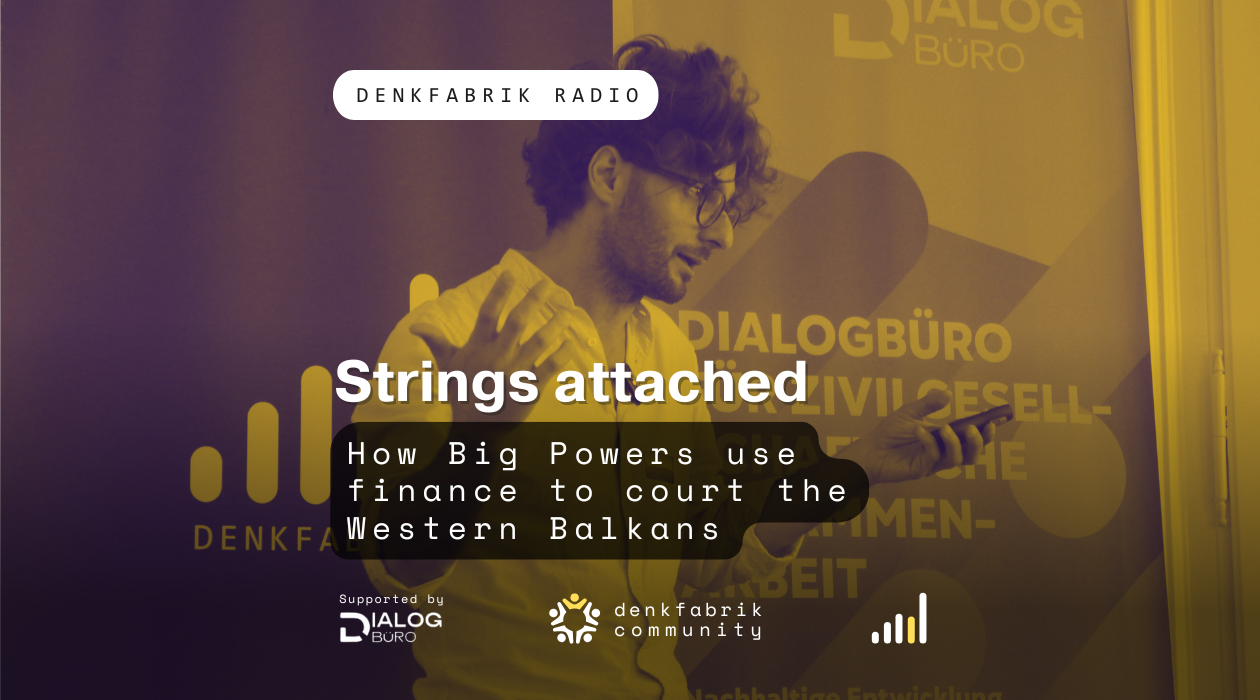
Leave a Reply